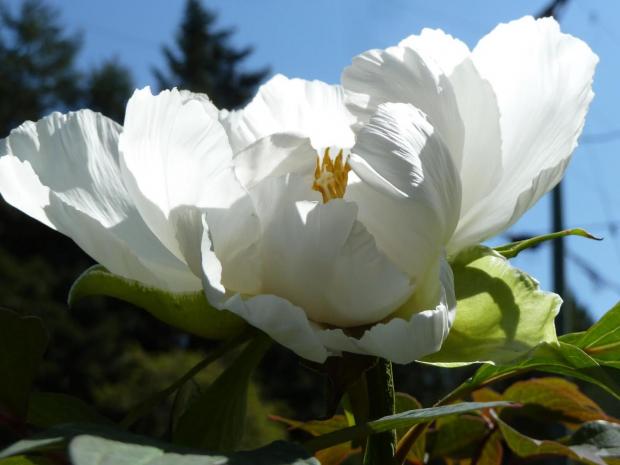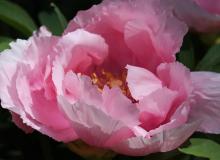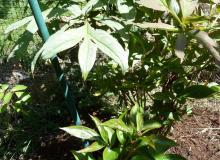
This is a story of my experience with peonies, particularly tree peonies.
I have found them to be well suited to the Pacific Northwest. Summer drought tolerant, deer resistant, (in my world deer proof plants are those inside yards with large dogs and surrounded by 7 foot fences) and tough as nails. I bought my first tree peonies some twenty five years ago, on sale at a grocery store. They have been transplanted three times, run over by a wayward car, stomped almost to the ground by a dog, given virtually no water all summer and still they come back year after year with gorgeous dinner plate sized fragrant flowers and lush foliage that come autumn turns lovely shades of red and purple. (yes some, but not all did sulk for a year or two after each upset, but I waited and soon the lush foliage and large flowers returned, the plant none the worse for wear.)
Peonies prefer heavy fertile soil but will tolerate leaner conditions. Good winter drainage is essential. They are sun lovers and prefer around 5 hours of sunlight . Their herbaceous growth ceases soon after the summer solstice, so summer watering is not required a year or so after planting. They are long lived plants, 50 years is not unexpected. Good drainage and good ventilation are key to having disease-free plants.
In my hands peonies do really well in the foreground of my seaside rose garden. The peonies flowers are finishing just as the roses are really coming to their own. Tree peonies flower first then the intersectional and the herbaceous types. (For increased drought tolerance I plant only own root hardy roses. Rosa rugosa hybrids and Meidiland roses do especially well in my ocean side zone 8b/9a gardens). Come autumn as the roses start to fade, the foliage of the peonies comes to life with colour. The tree peonies have the best fall foliage.
I found that both the peonies and the roses seem to have increased drought tolerance when grown near arbutus trees. I have read that the tree peonies don’t need staking but I have found that a strong ocean breeze can damage an unsupported tree peony in full flower. For support the large tomato towers work at least as well as the traditional peony rings. For ease of placement, they should be placed over the tree peony soon after planting. I leave them in place year in, year out. Intersectional and herbaceous do well when supported by peony rings. ‘The books’ say that tree peonies grow slowly, only about 1 to 6 inches per year. In my hands that seems to be true for the first few years, but once established they seem to grow at least twice that fast and despite the fact that I rarely fertilize the plants they soon are towering over me.
The Canadian Peony Society website has details on planting, propagation, care and diseases of peonies. I have been lucky to date and my Darwinian -survival of the fittest- approach to gardening seems to suit peonies well. They do not like overfeeding, overwatering, overmulching etc.
Genus Paeonia, the only member in family Paeoniaceae. Native to Asia, Southern Europe and Western North America.
Peonies have been cultivated for millennia. They do not like to be over fertilized. Hardy to zone 3 and deer resistant, peonies are long lived with fifty plus years being not unexpected.
Peonies are often divided into three types: herbaceous, intersectional (or Itoh) and tree.
Herbaceous Peonies are the most well known of the peony types. They are disease resistant and make great cut flowers . They die back to the ground in winter and reemerges early each spring with purple shoots that mature to lush bright green deeply lobed compound leaves.
Herbaceous peonies have been cultivated for centuries and come in a vast array of flower form and fragrance. They are available in a wide spectrum of colours from white through red, pink and purples but not in yellow or gold.
Intersectional peonies (Itoh peonies). Crossing herbaceous and tree peonies were attempted for many years without success until Mr Toichi Itoh’s cross of the tree peony Alice Harding’ and Lactiflora ‘Kakoden’ successfully germinated, some 3 years after his own death. With his widow’s permission they were introduced to the North American market, and the rest as they say was history. The plants have some the best characteristics of each of their parents. Yellow colours and huge flowers from their tree heritage, more compact size and better disease resistance from their herbaceous parents, with reportedly less susceptibility to powdery mildew and botrytis. And like their herbaceous parents they die back to the ground each year. A mature plant can produce upwards of 50 flowers over its 3 to 4 week flowering season. They now come in huge array of stunning colours and seem to be worth every penny of their priciness.
yellow itoh tree peony
Tree peonies have been cultivated for nearly two millennia. The Chinese tree peonies are often hybrids from the native plants. The flowers were revered for their beauty and medicinal powers and were at one time reserved for the emperors. The Japanese hybrids tend to have flowers that are more open, delicate and single than their Chinese peers. They are reportedly less vigorous and propagated by grafting while the Chinese ones are hardier and can be propagated by division.
Lynn Doyle MG - References Wikipedia, A to Z (Canadian edition), Canadian Peony Society, The Peony Society, Cornell University Diseases of Plants, Missouri Botanical Garden








